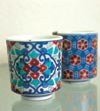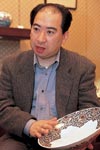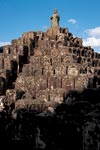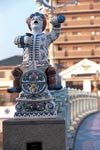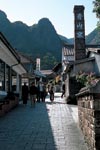|
|
 |
(10)(11) |
Painting picture ware at the Imaizumi Imaemon Kiln in Akae-machi. Everything is quiet—eyes concentrate exclusively on small details on the partially finished porcelain. |
|
|
|
 |
(12) |
Iroe yusoku mon containers made in the Nabeshima style. Late 17th century. Property of the Imaemon Museum of Ceramic Antiques, which is located next to the Imaizumi Imaemon Kiln. The museum displays some of the best Arita ware, especially Nabeshima ware. Japanese-language website:
http://www.imaemon.co.jp/museum/ |
|
|
|
 |
(13) |
Imaizumi Imaemon the 14th. He took this name in February 2002. Of all the methods passed down through the generations, he is especially fond of the sumi-hajiki method of porcelain dyeing that plays up the white background. |
|
| |
 |
(14) |
Imaemon Residence. |
|
| |
 |
(15) |
Tonbai garden wall with bricks and tools once used to make climbing kilns, all held together with a reddish clay. |
|
|
|
 |
(16)
|
The large torii gate at Tozan Shrine is made of dyed karakusa-mon porcelain. |
|
|
|
 |
(17) |
Evening scene on the
Imari River. Years ago,
vast quantities of Arita ware passed out from the river mouth bound for other ports
in Japan and abroad. |


